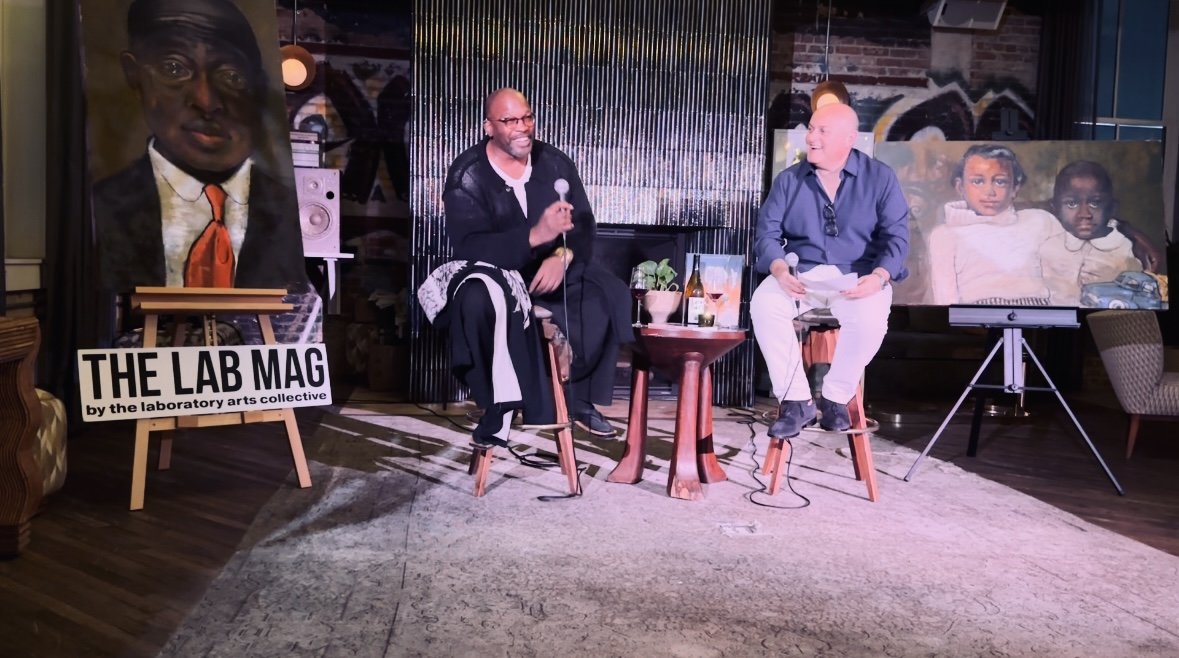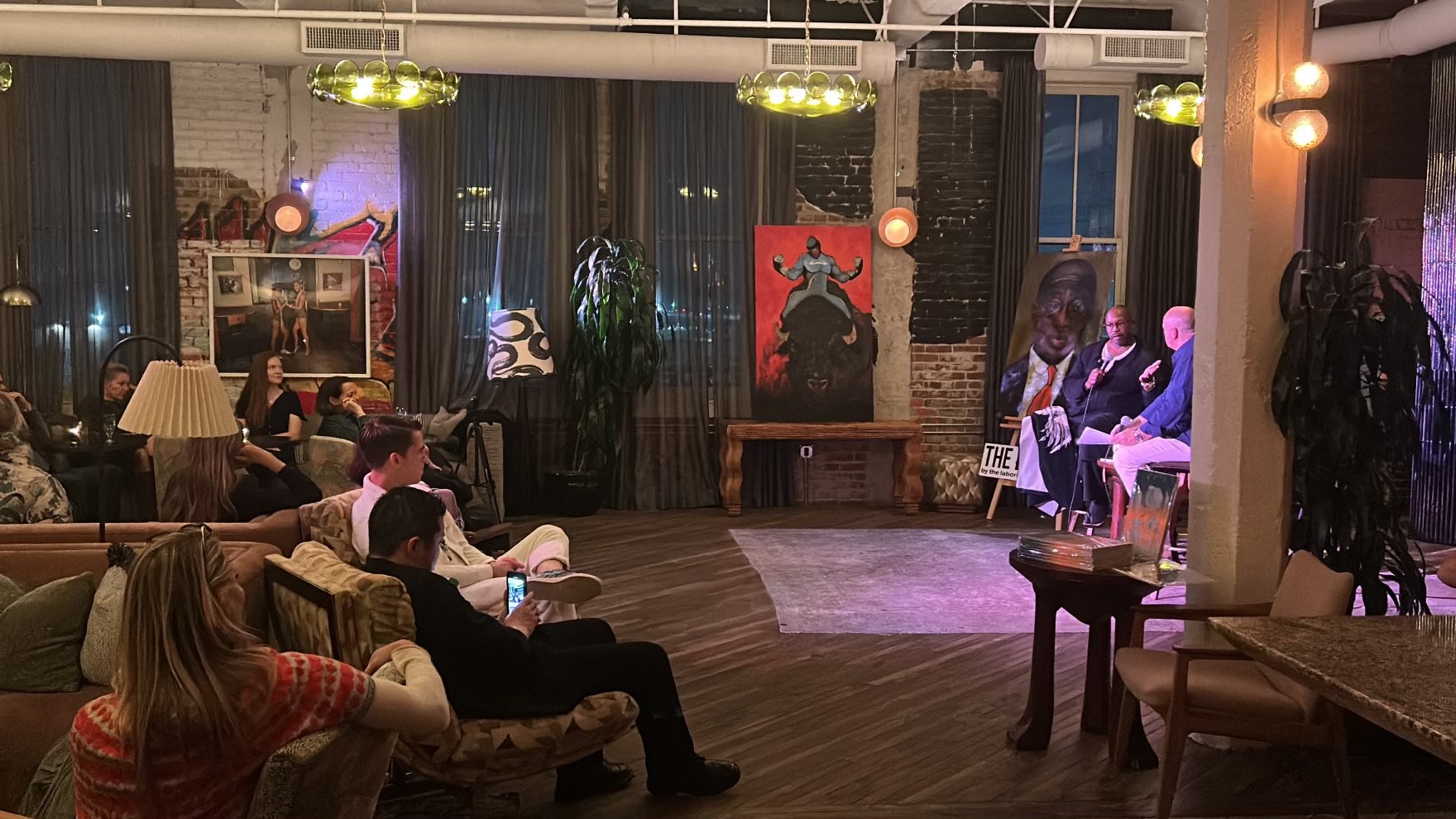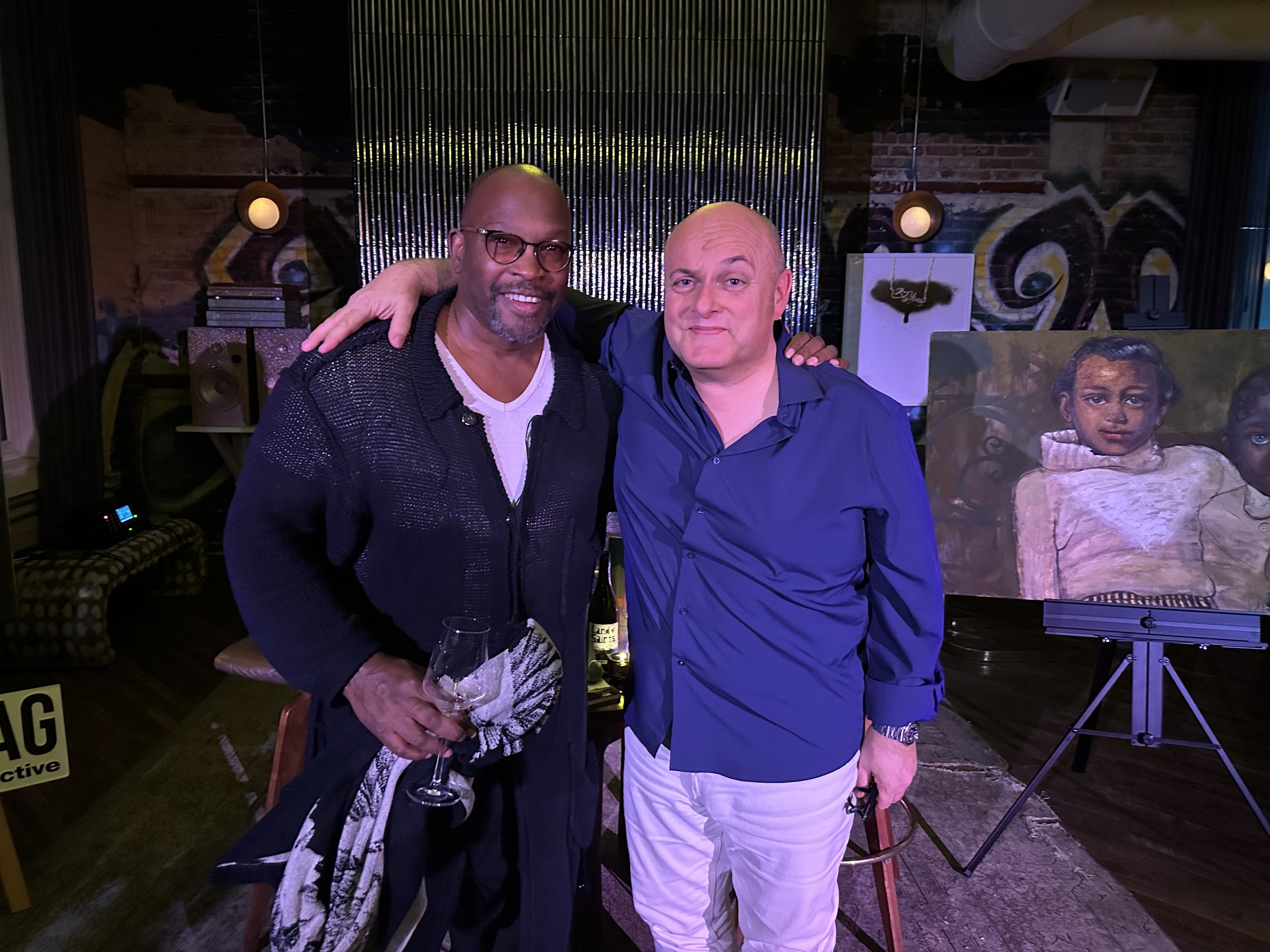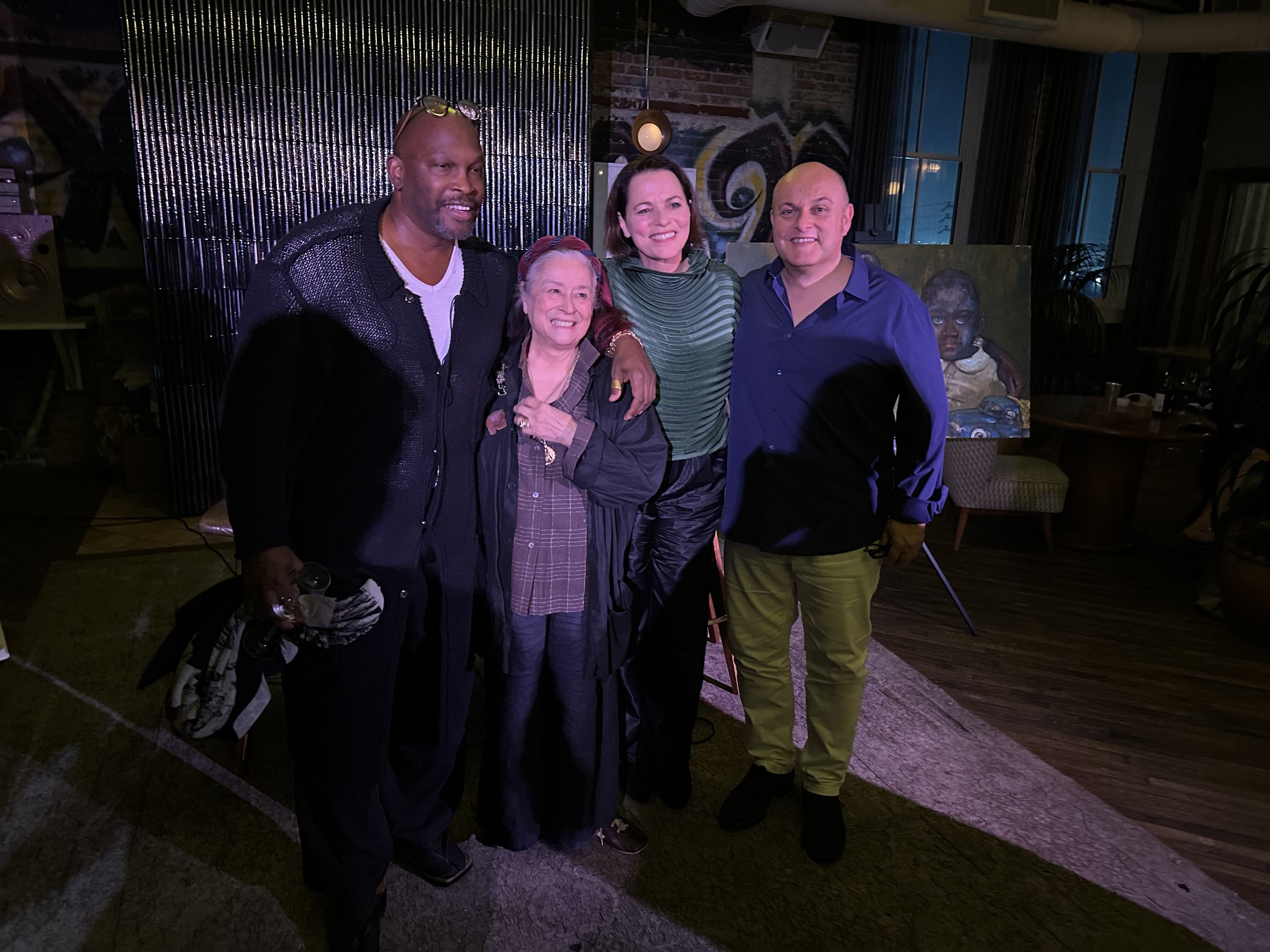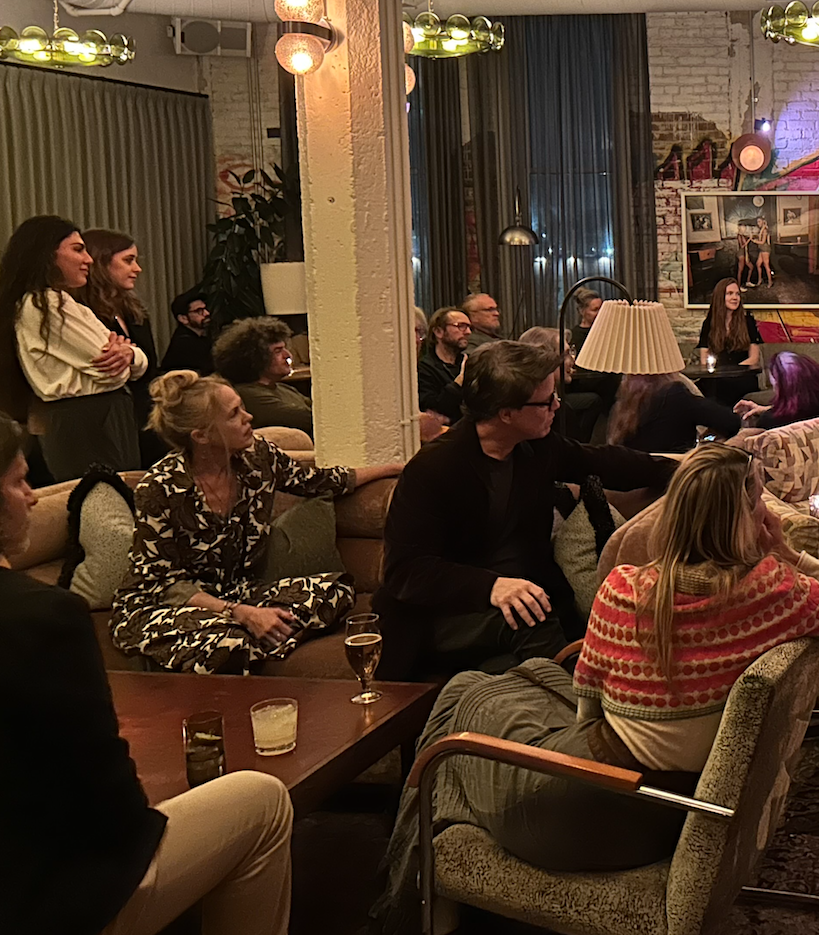CHAZ GUEST IN CONVERSATION
SOHO HOUSE X THE LAB MAG
SUNDAY NOV 27th
ARTIST CHAZ GUEST IN CONVERSATION WITH THE LAB MAG PUBLISHER NIGEL DALY.
Photograph by Brian Bowen Smith
"When I'm painting a portrait, I finish the eyes and mouth first... so my subject can speak to me. Searching for the DNA of everything I approach.”
Soho Warehouse, downtown Los Angeles, Members and friends gathered in December for our first event since lockdown.
Artist Chaz Guest joined The Lab Mag Publisher Nigel Daly in a conversation. For those who could not be with us, this is an abridged and edited version of their exchange.
Nigel Daly: So Chaz and I decided to have this conversation with a fine bottle of red wine. Cheers.
Chaz Guest: Cheers.
Nigel: Now, Pablo Picasso once said, 'every child is an artist. The problem is how to remain an artist once you grow up.' So, I'd like to start with that. Chaz, tell us about your childhood and the journey to creativity. Does the child still reside within?
Chaz: Well, first of all, how much fun is it being an adult? My childhood lives with me all the time. I have flashbacks and recollections constantly. My job as a little boy was digging for worms in Niagra Falls for my dad to go fishing. So that put me very close to the earth. And colouring. Colouring books. We didn't have many toys, but the very few that I had, I searched for them and found them on eBay, and I have them now, like the little Gaylord dog, the easy bake oven, Rok and Sock Robots; they're all in my garage. So, to answer your question, for me it's imperative, it's one of the most important things. There are so many constructs and things up in our heads as we grow and I think they can truly get in the way.
In my experience, I'm not speaking for everybody, but I can say I lived in Niagara Falls from zero to 10, and at that time I was pretty much isolated from the world and the goings on. It was my dad preaching in church, which was tremendously boring.
Laughter
Watching the Falls; they were lit up at night, the Dairy Cream ice cream, digging for worms as I mentioned, and just colouring, sort of like quiet, and just looking. And now as an adult, I try to do my best to move life out of the way so that I can paint, you know?
Photograph by Haoyuan Ren
Nigel: As you became an adult, you moved into some really wonderful spaces, you were a gymnast, and you are a martial artist?
Chaz: I did gymnastics to the hilt. I was on the top team in the United States. But the Olympic team was just a whole other story. Those guys were the lords of gymnastics, and they were my coaches. As a guy gymnast, as we get older in gymnastics, not only do we get smarter, but our muscles get smarter. And I remember dismounting at my last competition at the championships where I took fifth place, which was very satisfying for me and accomplished in my own way because I set my realistic goals, you see? I did that for a very long time. I wrecked my body for that sport.
Nigel: And then you moved into martial arts?
Chaz: Yes, yes.
Nigel: And tell me, this work with your body and the martial arts, how, how would you say that influences your work as a painter, as an artist?
Chaz: Yeah. I'll get to that. Well, let me push that back because I think it's important for me to tell this part of that story. You've been to my place and as you know, it's very butoh. When I was 10, my parents divorced and my mother took all nine of her children to the inner city of Philadelphia. And it was like my life was cut. And then real life started in the inner city because I was like, "Whoa, what is this? A metal train? A lot of people." And it was a trip, and I was a daddy's boy without knowing it because I needed that male influence in my life.
The 1976 Olympics were on television, and there was a Japanese gymnast by the name of Shun Fujimoto. And, you see, I didn't know the difference between Japanese, Chinese, Korean, or any Asians. I didn't know the difference. They looked like little origami men. And they were perfect in the way that they moved about. And Fujimoto dismounted off rings with a broken patella and a broken knee, and he didn't tell his teammates so as not to disturb their spirit… So… when you see this guy dismount off of rings and he lands like that, and he turns around like that… and I was this little boy looking at that. And, you know what I said? I want some of that. Now, how weird is that as a little boy? That's pretty freaking weird.
But I said I want that thing. And as the universe would have it, my brother came from Okinawa from training with Mas Oyama in the Art of Kyokushin Karate. So he came back to Philadelphia with this book called, This is Karate. And I looked at it, and it was the same damn Japanese guys as in the book! And I was like, well, what is this called? This is called Bushido, it is the Way of the Samurai. And as a little boy, without knowing anything about that, I just fell into it. I want that. I want to be that dedicated to something. So I followed that to the hilt, you know, and I followed my karate life after gymnastics all the way to Tokyo. Mas Oyama passed away in 1996. And my Sensei passed away just a few years ago. So that's that story.
BLACK BELT - KYOKUSHIN KARATE
So the question you asked is, how does that influence my art? Right? I give everything that I have. And when you give everything that you have, in the most respectful way, criticism does not exist for me. Because I've given you everything I've got. And that's enough for me. It's enough for me to have my two sons say, "dad, that's dope," and I'm done. So it influences me because having that background, the discipline, it is extraordinary. And I needed that discipline. I might add this too… sitting in church in the front row, hungry and sleepy, having to listen to my dad is discipline of monk proportions. So all of that plays into my story, you see?
Everybody in this room, we have our own personal stories that keeps us going. Mine is very highly disciplined. And I needed all of that stuff to land in New York City in 1986. I needed every morsel of that.
Photograph by Haoyuan Ren
Nigel: So let's go back to that 1986 New York City story, where at that point, you were looking at illustration. So tell us where did it all begin? Because there was Paris too, and there was a jump off point in Paris where you decided that fashion illustration may not be your thing?
Chaz: You know, that's a beautiful story. I'm gonna make it as short as possible, but it's a beautiful story because I'm talking about how you can't do this by yourself. There is a divine order that has to happen in one's life. I've got that thing.
I landed in New York City, I didn't know my ass from my elbow. And I was very weird because I was fully in shape. I had no knowledge of my place in the outside world leaving my bubble of gymnastics and I met Andy Warhol and Christopher Makos walking down the street. Andy went "Whoa…." And I went, "Whoa…." We both "whoaed" at each other because he looked like an alien. And I must have looked like an alien at that time. And, Christopher photographed me and they took me into their world.
Chaz turns to Joan Quinn (Former west coast editor of andy warhol’s interview magazine) SITTING in the audience.
Chaz: Well, Joan can vouch for me, he was quite an alien, right?
JOAN nods in agreement.
But I landed in that world, in New York City that I didn't want any part of. And my discipline kept me focused on what it was I was trying to do. I actually wanted to be a fashion designer. I rode myself into F.I.T. (Fashion Institute of Technology) and after nine months, the teachers were asking ME questions. I would draw stuff and it was second nature. And I said, "Well, if I'm paying and they're asking me questions, that's okay, but what's the next move?" Then I met this great guy named Antonio Lopez.
Antonio Lopez at Cafe Flore
He did a lecture demonstration at the school. And… this guy… the way he drew, I wanted that thing, just like Shun Fujimoto, right? And, I followed him around to the cafeteria, you know, like the Pink Panther. And I got his number and I wound up at his studio and I said, you just need to show me how to do some of this illustration.
Antonio Lopez / Courtesy of The Estate of Antonio Lopez and Juan Ramos, 2012. From Antonio Lopez 1970: Sex Fashion & Disco directed by James Crump
He looked at me drawing, and he said, you have to relax and this kind of thing. He said "When I come back from California, I'll introduce you to Karl Lagerfeld." Unfortunately and sadly, he died of AIDS in California. And I read it in the newspaper. That lit a fire in me. And I got into fashion illustration and I got a one way ticket to Paris with no money. And not even an idea crossed my head about getting back. I'm talking about falling with style! You know, my brother used to play that game with me. You fall back and he's gotta catch you. Or not. Yeah, they were ruthless.They didn't catch me a lot.
But I bought that ticket. Now you know, when you try to do stuff in your life and you over focus and it's just not coming, and you get frustrated, guess where your blessing's gonna come from sometimes? Good deeds.
I was on Rue de Rivoli with all my papers and brushes in my hand and this skinny lady was carrying this gigantic bag. And I ran across the street and I said in my little bit of French, "Ma'am, can I help you with your bag? How far are you going with that thing?" And she's going to the Hotel Konfidentiel. So I grabbed her bag and I carried it. It was Katoucha who was the top runway model in Paris at that time.
And she kissed me on my cheek and said, "You want to go to a party?" I was like, "I'm not dressed for a party." She said "Come in any way and have some champagne." So we open the door and it was a party for Yves Saint Laurent. So all of my going around Paris trying to introduce myself to all these magazines and them not even offering me a glass of water…
Nigel: …in one night, it happens.
Chaz: And the guy I remembered from Joyce Magazine, he's standing over there and he sees me with all of these beautiful models. So of course he makes his way over and he says, "You want to do the cover of the magazine? Be in my office tomorrow." That catapulted my career as a fashion illustrator.
Chaz Guest cover of JOYCE magazine
Nigel: Fate.
Chaz: Good deeds.
Nigel: So your life has been orchestrated by your own deeds. You know, you push and you ask questions and you find your way. But also some level of fate plays into this.
Chaz: It's called divine favour. It's not luck. It's divine favour. Because I trust that. And it has been very, very good. I trust it without a doubt in my whole body.
"The greatest thing that people get from my paintings is seeing themselves within them - no matter who you are," Guest concludes. "By the time I leave this earth, I want to see people moving closer together."
ABOUT CHAZ GUEST
Typically donned in a Japanese kimono and slippers in his Mid-Wilshire Los Angeles studio where he is surrounded by bold, beautiful Africa-originated inspirations, Guest captures light energy and life legacy in his works.
His works are found in lofty spaces of distinction; President Barack Obama, Beth Rudin DeWoody, Oprah Winfrey, Stanley Clarke, Angelina Jolie, Tyler Perry, Spike Lee, Ted Sarandos, the Bob Rennie Collection and the collecting duo Arthur Lewis and Hau Nguyen, to name a few.
Chaz is represented by Night Gallery in LA and Vito Schnabel Gallery in NY.
Chaz Guest is featured in the STORY issue.
Thank you to the members and friends who joined our evening.
We look forward to seeing you again.

